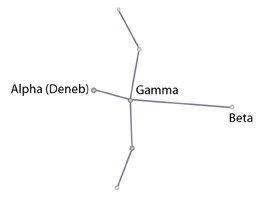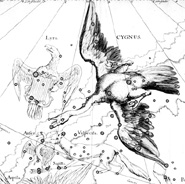also (modern) Northern Cross
Location: Northern Hemisphere
Coordinates:
Right Ascension: 21h
Declination: +40º
Source: Greek mythology, also Arab
The story behind the name: Cygnus is one of the older constellations recognized by early civilizations. It was first seen as a bird or a hen, but became associated with several Greek myths involving swans. The shape of the constellation with a short tail and long neck stretching out suggests a flying swan more than the other birds.
As with other more ancient constellations, a number of myths have been proposed as the inspiration for the image. A well-known myth is the story of Zeus who disguised himself as a swan to seduce Leda, mother of Helen of Troy. Various children are attributed to that liaison - Helen, Clytaemnestra, Castor, and Pollox - but only Helen is consistently named as a child of Zeus.
Variants on this myth have Zeus seducing Nemesis, goddess of the Pelopennesian swan cult. In some variants, Nemesis is also able to transform herself into a bird. She lays an egg from which Helen will be born, but gives it to or leaves it for Leda to find. Zeus was supposed to have placed the image of a swan in the heavens to commemorate the success of his trickery.
Another myth which may be represented by the constellation is the story of Cycnus, son of Aries, who was transformed into a swan when he died.
Introduction to Constellations | Constellation Sources | Constellations Index
Objects observed by Chandra in Cygnus:



